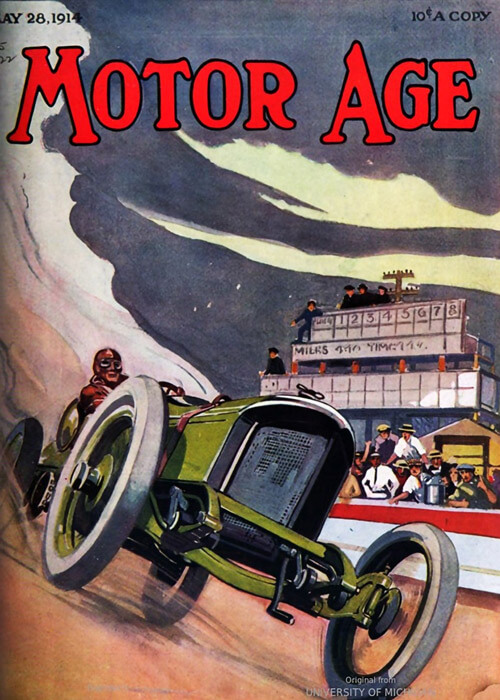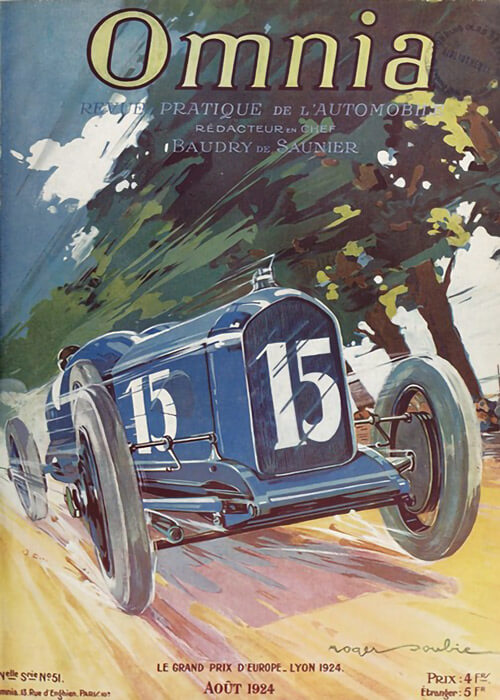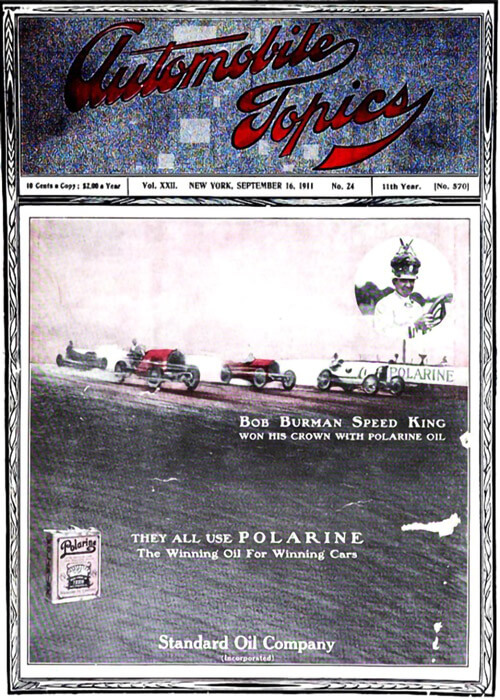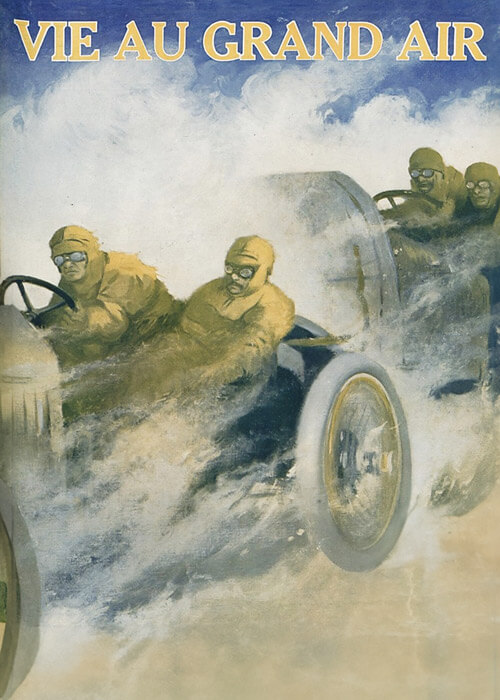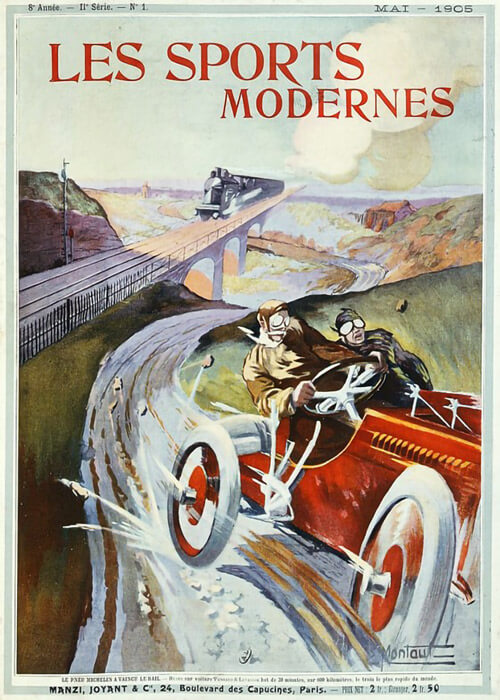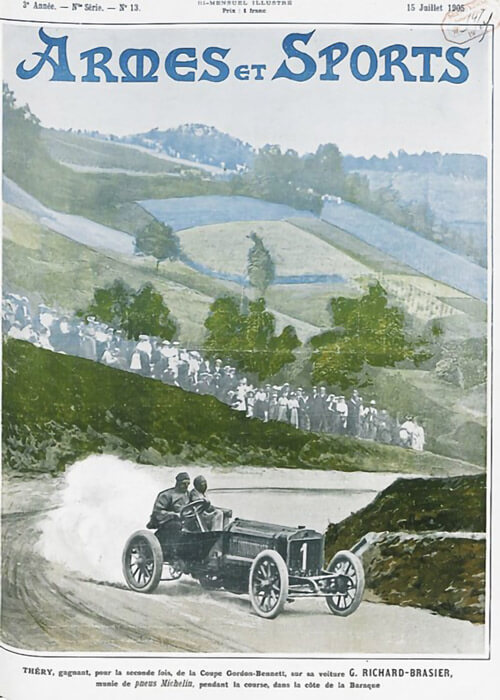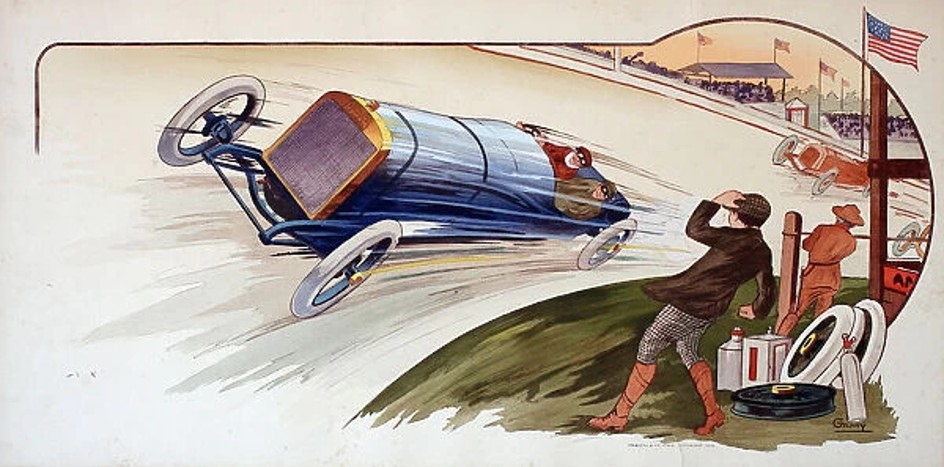
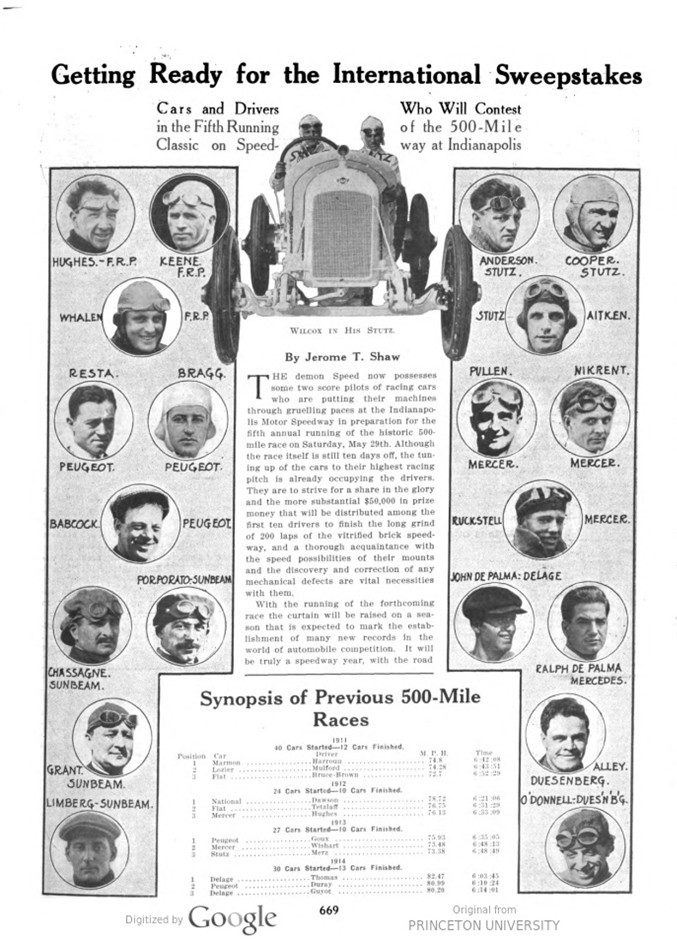




Text and jpegs by courtesy of hathitrust.org www.hathitrust.org, compiled by motorracinghistory.com
Horseless Age, Vol. 35, No. 22, May 19, 1915
Getting Ready for the International Sweepstakes
Cars and Drivers Who Will Contest in the Fifth Running of the 500-Mile Classic on Speedway at Indianapolis
By Jerome T. Shaw
THE demon Speed now possesses some two score pilots of racing cars who are putting their machines through gruelling paces at the Indianapolis Motor Speedway in preparation for the fifth annual running of the historic 500-mile race on Saturday, May 29th. Although the race itself is still ten days off, the tuning up of the cars to their highest racing pitch is already occupying the drivers. They are to strive for a share in the glory and the more substantial $50,000 in prize money that will be distributed among the first ten drivers to finish the long grind of 200 laps of the vitrified brick speed- way, and a thorough acquaintance with the speed possibilities of their mounts and the discovery and correction of any mechanical defects are vital necessities with them.
Synopsis of Previous 500-Mile Races
1911 – 40 Cars Started – 12 Cars Finished.
Position Car Driver M. P. H. Time
1 Marmon Harroun 74.8 6:42:08
2 Lozier Mulford 74.28 6:43:51
3 Fiat Bruce-Brown 72.7 6:52:29
1912 – 24 Cars Started-10 Cars Finished.
1 National Dawson 78.72 6:21:06
2 Fiat Tetzlaff 76.75 6:31:29
3 Mercer Hughes 76.13 6:33:09
1913 – 27 Cars Started-10 Cars Finished.
1 Peugeot Goux 75.93 6:35:03
2 Mercer Wishart 73.48 6:48:13
3 Stutz Merz 73.38 6:48:49
1914 – 30 Cars Started-13 Cars Finished.
1 Delage Thomas 82.47 6:03:45
2 Peugeot Duray 80.99 6:10:24
3 Delage Guyot 80.20 6:14:01
With the running of the forthcoming race the curtain will be raised on a sea- son that is expected to mark the establishment of many new records in the world of automobile competition. It will be truly a speedway year, with the road races of yesteryear only a small feature Indianapolis no longer on the calendar. monopolizes the field of speedway contests, for before the season closes the specially constructed motor speed courses at Chicago, Sioux City, Tacoma, Omaha, Providence, Twin Cities, Detroit and Sheepshead Bay are scheduled to be the scene of long, strenuous battles of endurance and speed, prize money aggregating over a quarter of a million dollars being offered for the successful pilots.
While it is to have competition, the Indianapolis race still occupies the premier position in American motoring events because of the past performances at the Hoosier course and the position it holds as curtain raiser for the 1915 season. The 1915 500-mile race bids fair to be- come as interesting as any of the previous long grinds on the Indianapolis course, though from the standpoint of international flavor the entries this year are not as strong as in the contest last year, when the cream of European land pilots invaded the American field, and returned home burdened with bags of American gold as prize money and with speed records to their credit such as had never before been made in a speedway race in this country. The forthcoming race, despite the conditions now prevailing on the other side of the Atlantic, has its quota of foreign entries, but there are only three European drivers scheduled to battle with the Americans, as against eight in last year’s race.
Thomas, Goux, Boillot, Christiaens, Duray and Friedrich, the first five of whom finished among the first six drivers in the race of last year, will be absent this year, but two new invaders will take their places and will deserve the careful consideration of the American drivers. Dario Resta, the English-Italian pilot, who marked his entrance into American contests with the winning of the Grand Prize of the A. C. A. and the Vanderbilt Cup at the Panama-Pacific Exposition course, is the chief favorite as a contending possibility in the foreign ranks. Resta will pilot the Peugeot car, the same make of machine which carried him to victory in the San Francisco races, and, with his familiarity with the Brooklands speedway in England standing him in good stead, he is expected to offer the array of American drivers the strongest battle for the prize money. Jean Porporato and J. Chassagne are the two other foreign drivers entered. Porporato, although he has been heralded as a „pilot from Spain,“ is really an Italian. With Chassagne, whose Sunbeam was wrecked early in the 1914 race, Porporato will make up the Sunbeam factory team, who are prepared to battle with their European rivals-the Peugeots.
There will be seven cars of foreign make piloted by American drivers, with Ralph De Palma in his Grand Prix Mercedes heading the list. De Palma has been reserving this car for the forthcoming race and it is expected to show startling speed. A new member of the De Palma family, who will make his first appearance in an important race, is John De Palma, who will be seen at the wheel of the Delage which Rene Thomas piloted to a new record and first place last year. This machine has been entirely overhauled and reconstructed to meet the requirements of this year’s race. Barney Oldfield, the first American to finish last year, has placed his reliance on a new mount and will pilot the German Bugatti, a car which Friedrich drove last year and which was eliminated after traveling 330 miles, when a roller bearing broke. Caleb Bragg, formerly of the Mercer team, is a last minute nomination of the Peugeot entrants, succeeding Frank Galvin to one of these mounts. George Babcock is another native driver who will handle a Peugeot. Harry Grant and Carl Limberg are the other American drivers of foreign mounts, both men being nominated to drive the two Sunbeams entered by the Fortuna Racing Team, Inc.
With the experience of last year strongly in mind, American manufacturers and entrants have prepared to meet the invaders with machines that have proved to be fast. Last year several American cars participated that were capable of holding their own with the foreign speed creations, but the fortune of the game was against them and their drivers had to be content to trail after the flying Delages and Peugeots in the standing of the race. This year it is believed that the domestic cars will make it more interesting for the drivers of foreign cars. There will be six teams of American cars upholding the speed records of this country, and they represent a formidable collection of speed machines. The sturdy Stutz, one of which was the first American car to finish last year, promises to be a strong contender, with Anderson, Wilcox and Cooper as pilots and Aitken as relief. Mercer will again have three cars entered, with Eddie Pullen, the road race-record holder, as captain of the team, and the two Westerners, Nikrent and Ruckstall, as his teammates. The Maxwell team will consist of Rickenbacher, Carlson, and probably Dawson, while two of the three Duesenberg pilots will be Alley and O’Donnell. The third has not been announced. The Bergdoll brothers, Grover and Erwin, with Willie Haupt, will handle the Bergdolls.
When the entry list closed, on May 1st, 41 cars were nominated to participate in the race. This is four entries less than were received last yar, but it is eight more than will be permitted to start in the contest. Under the rules governing this year’s race, 33 cars is the maximum number allowed to face the starter, this being three more than the limit last year. The limitation of the field of starters, therefore, will develop an interesting contest in itself, for, according to the rules, only the fastest of the 41 entries will be included in the starters.
As was the case last year, these speed trials will really be elimination tests, and desperate efforts are being made by the drivers to have their mounts capable of their highest speed on May 20th, 21st and 22nd, when these trials will be held. Each driver is determined not to be forced out of the race for a fortune, and when he is sent over a lap of the 22-mile track in the time trials he will let nothing prevent him from getting all possible speed out of his car.
More stringent requirements are made of the entrants in the forthcoming race than in previous „five century grinds.“ Not only have the promoters reduced the piston displacement from 450 to 300 cubic inches, but they have also increased the speed requirement in the elimination trials. Each car will be required to show a speed of 80 miles an hour for a full lap of the course. Last year, when the speed limit was placed at 75 miles an hour, it was considered that this was sufficiently high to eliminate many of the cars, but in the trials few found difficulty in making the required speed, while several of the cars averaged close to 90 miles an hour in the test.
Railbirds at the Speedway are having trouble solving the speed problems offered by the entrants this year, for daybreak is the favorite time selected by the drivers for their try-outs. Already a few of the cars have shown great speed in the trial dashes around the course, though many of the drivers now at the scene of contest have been content to „jog“ over the bricks, unlimbering for the official trials later in the week. Howard Wilcox, the newcomer in the Stutz ranks, is reported to have established a new Speedway record for the year during one of his trials, when he reeled off a lap of two and one-half miles in 1:34:08, an average of 95 miles an hour. Boillot holds the lap record for the course, having covered a circuit in the elimination trials in 1:30:13.
This year will mark the advent of the small car in the American racing field. The 300 cubic inch piston displacement limit is the result of a „trend“ toward smaller engined racing cars that has been noticeable for several years in Europe and is in line with the now predominating practice with the American automobile manufacturers. The first two 500-mile races were open to cars of under 600 cubic inches piston displacement, which made it possible to enter specially constructed and freak racing cars, to the detriment of the chances of the more generally used small displacement chines. In 1913 the limit was reduced to 450 cubic inches, and the same conditions governed last year. Of the 45 cars nominated last year, 25 had piston displacements exceeding 400 cubic inches, while six were below 300 cubic inches.
There is but one car – the Bugatti – nominated for the 1915 event that has a displacement of 300 cubic inches. The Kleinart, to be driven by Klein, closely approaches the limit with 299.5 cubic inches, while eleven machines are listed at 299 cubic inches. Ten cars are within two inches of the limit, these including the Maxwell and Mercer teams. The three Stutz cars have a displacement of 296 cubic inches. Nine cars are in the division from 270 to 280, prominent among which are the F. R. P., the latest speed creation of Finlay P. Porter, former de- signer of the Mercer cars, the four Sunbeams, De Palma’s Mercedes, and Resta’s Peugeot. Louis Chevrolet has been entered with the smallest car, the piston displacement of the Cornelian being 103 cubic inches. Bragg and Babcock’s Peugeots and the Du Chesneau are next, with 183 cubic inches.

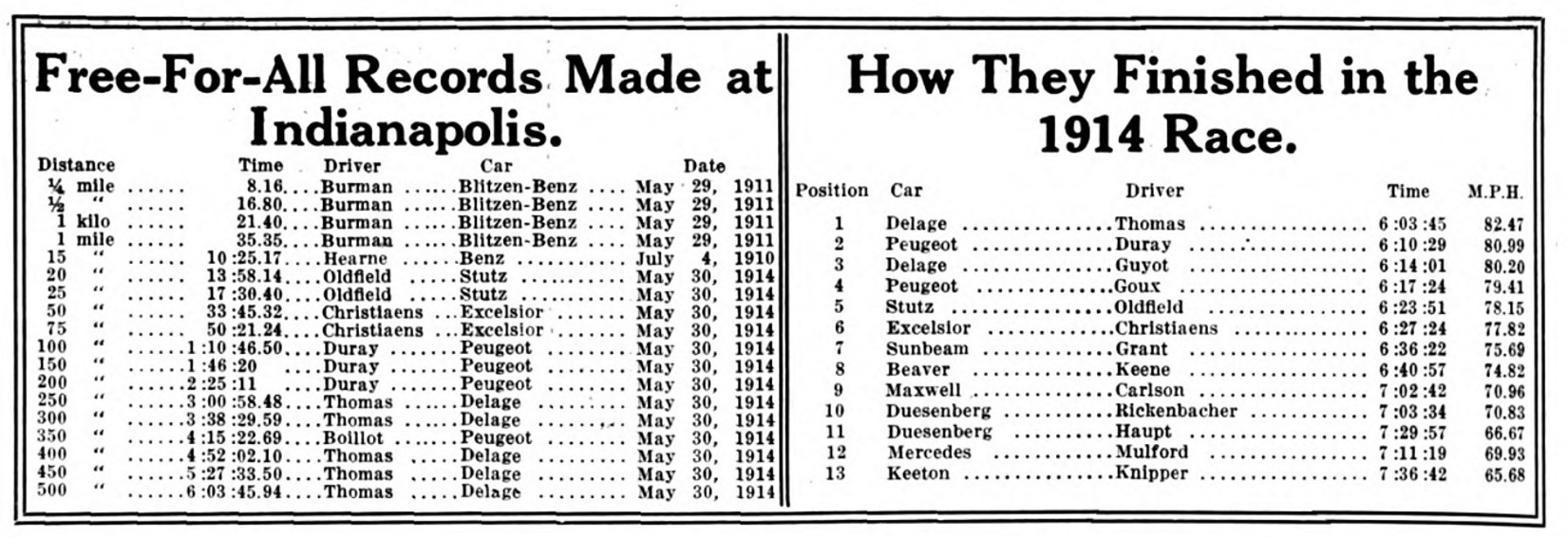

A medium sized fortune will be won by the driver who is the first to pilot his car across the finish line. He will receive no less than $20,000 for his day’s work. The second and third men to finish will not fare badly either, they receiving $10,000 and $5,000, respectively, as their share of the purse. As was the case last year, the remainder of the purse will be divided among the next eight men to finish, as follows: Fourth, $3500; fifth, $3000; sixth, $2200; seventh, $1800; eighth, $1600; ninth, $1500, and tenth, $1400. In addition to these prizes offered by the management of the Speed- way, the successful drivers will share in the money prizes offered by various accessory manufacturers.
Not only will the successful drivers be awarded cash prizes, but, as a special incentive for record-breaking speed, the management has also put up as prizes several well-known motor contest trophies, which will be awarded to the leaders at intermediate distances in the race. The G. & J. Trophy will be awarded to the entrant of the car leading at 100 miles; the Remy Grand Trophy and the Remy Grand Brassard will be awarded, respectively, to the entrant and driver of the car leading at 200 miles; the Prest-O-Lite Trophy to the entrant at 300 miles, and the Wheeler-Schebler Cup at 400 miles.
The starting of the 500-mile race is a gigantic task in itself and calls for the display of a cool head and fine judgment on the part of the drivers. As has been the practice since the first of these races was run, the cars will be lined up at the starting point and promptly at 10 o’clock will be sent away, to follow the pace set by an official in a non-contesting car for one lap of the course. At the completion of the circuit, the latter part of which will be made at high speed, the official’s car will draw off the course and the con- test will then be on in earnest. Positions during the flying start are determined by the speed of the cars in the elimination trials, thus putting the fastest cars in front.
Officials of the race have been David announced as follows: Beecroft and F. A. Croselmire, of New York, American Automobile Association representatives; A. R. Pardington, of Detroit, referee; F. E. Edwards, director of contests of the Chicago Motor Speedway, Chairman of the technical committee, and Tom Hay, of Chicago, starter.
Photo captions.
Page 669
WILCOX IN HIS STUTZ
HUGHES. F.R.P. – KEENE. F.R.P. – WHALEN F.R.P
ANDERSON. STUTZ – COOPER. STUTZ. – AITKEN. STUTZ.
RESTA. PEUGEOT – BRAGG. PEUGEOT. – BABCOCK. PEUGEOT.
CHASSAGNE. SUNBEAM. – PORPORATO SUNBEAM. – GRANT SUNBEAM. – LIMBERG-SUNBEAM.
PULLEN. MERCER. – NIKRENT. MERCER. – RUCKSTELL MERCER.
JOHN DE PALMA. DELAGE – RALPH DE PALMA MERCEDES.
ALLEY. DUESENBERG. – O’DONNEL. DUESENBERG.
Page 670
THE SMALLEST CAR IN THE CONTEST. LOUIS CHEVROLET IN HIS CORNELIAN BURMAN. BURMAN SPL. – RALPH MULFORD. MULFORD SPL.
HARRY G. DONALDSON, EMDEN. – BILL HAUPT, BERGDOLL.
Page 671
THE ROAD RACE RECORD HOLDER, PULLEN, WILL DRIVE A MERCER.
BARNEY OLDFIELD. BUGATTI – ART KLEIN KLEINART
GROVER BERGDOLL. BERGDOLL – ERVIN BERGDOLL BERGDOLL
The Upward Tendency of the Winner’s Speed. What Will It Take to Win This Year?
MILES PER HOUR / YEAR
1911 MARMON 74.59. HARROUN
1612 NATIONAL. 78.70 DAWSON.
1913 PEUGEOT. 75.95 Goux.
1914 DELAGE. 82.47 THOMAS.
Page 672 – CARLSON, DAWSON AND RICKENBACHER, DRIVERS OF THE NEW MAXWELL RACERS.
